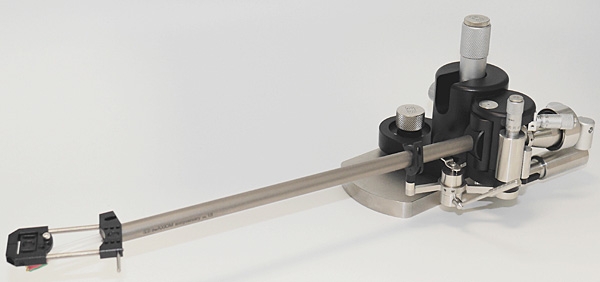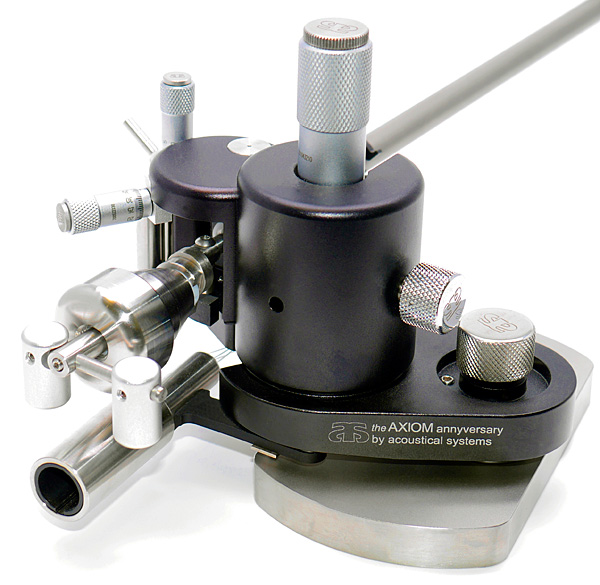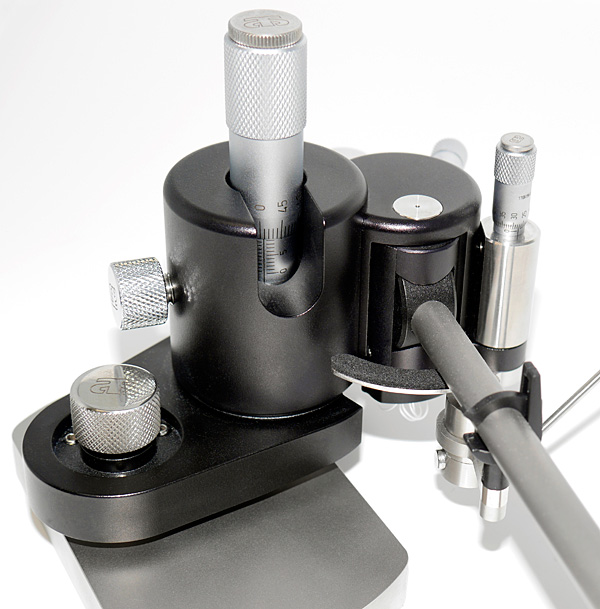| Columns Retired Columns & Blogs |
Very SAD to see Michael Fremer leave Analog Planet . Very HAPPY to see Malachi Lui leave Analog Planet .

The understated, "lab-grade" AXIOM holds its own visually even when paired with designer D.D. Brakemeier's enormous and equally lab-looking APOLYT turntable. You can take the turntable tour on AnalogPlanet or on Brakemeier's website. That turntable's scale makes even the TechDAS Air Force Zero appear diminutive.
Brakemeier, who describes himself as the "chief design officer, so to speak," says his goal for the $24,995 AXIOM was to produce an infinitely adjustable "universal" tonearm capable of precisely adjusting every setup parameter you can think of and maybe a few you haven't thought of and to place the settings where they are most effectively implemented.
Available in either 10" or 12" versions (and in various other optional configurations you can find on the company's website), the AXIOM is a double nano-gimbal bearing, static, full-lateral-balanced arm. According to Brakemeier, the bearings are not the usual ABEC-7 or -9 variety but rather are made for use in satellite gyroscopes and for other high-precision purposes. Only two companies make them: one in Japan, the other in Germany; the latter, obviously, is where the AXIOM's are sourced. The pivoting architecture consists of four bearings in three sizes. This eliminates, Brakemeier says, "resonances in any of the two axes." The horizontal bearing features a hardened, beryllium-brass alloy. The vertical bearing is fabricated from tungsten HD18. These material differences are also intended to reduce resonances.
Brakemeier further explained why the ABEC "ball race" scale (footnote 2) is useless for tonearm bearings, though many arm manufacturers tout them. Those, he says, are for use in high-speed settings where there's constant vertical as well as angular pressure. Tonearm bearings use but a fraction of a full revolution; the important thing is that the inner movement within that small fraction of a revolution must be as smooth as possible and feature as low as possible inner inertia—the force required to start "the ball rolling"—which should also be as low as possible. This makes so much sense, it's obvious why I never thought of it!

For this application, the way the ball is embedded into the housing is critical and must be performed under high temperature to expand the space in which the ball sits. Once the material cools down, it shrinks in size, assuring a tight precision fit. That's why these are special-use bearings. It also demonstrates how ridiculous it is when a manufacturer spins an ABEC-9 bearing to impress you by how freely it spins. That's not what's useful in a tonearm bearing!
"Static" means that the tracking force is set by moving a weight forward or back on a counterweight stub as opposed to using a spring applied at the pivot point: a spring force is "dynamic" because it changes significantly as the angle changes. "Full lateral balance" refers to counterbalancing "the breakdown torque effect of the offset angle," where the combined weight of the cartridge and headshell produces a lateral force that unevenly "torques" the horizontal bearing (the one that allows vertical movement).
This force is static in a gimbaled arm, but in a unipivot arm, it's dynamic: Unless it's compensated for, it causes the arm to noticeably tilt, something every unipivot arm owner knows. It's a more subtle force in a gimbaled-bearing arm, Brakemeier says, but as soon as the stylus is lowered into the groove, it increases inner-groove pressure.
Lateral balance compensation, Brakemeier avers, allows the arm to work well with less antiskating compensation. The feature was more commonly found on the best 1970s Japanese arms: Micro-Seiki, Fidelity Research, SAEC, and others. It's addressed in the AXIOM using a pair of weights hanging asymmetrically from a crossbar located near the rear of the counterweight stub.
Brakemeier claims that by carefully arranging the "split mass" weights and carefully choosing the right combination of main counterweight, secondary counterweight, and lateral balance weight—both aluminum and stainless steel pairs are provided—it's possible to fine-tune the arm's effective mass to match any cartridge compliance.
The arm combines a surface-hardened titanium outer tube and carbon-fiber inner tubes "blocked together" and internally liquid-damped by what the instructions claim is "an all-new design concept, a concept never before applied in tonearm design and first featured in the AXIOM." The result, the instructions claim, is "unmatched fast energy transfer and total absence of any parasitic resonances in the tonearm." The arm is wired internally with "soft aged pure silver Litz wire" (silver is generally brittle) and terminates in a straight DIN jack fixed within a tube placed parallel to the platter.
German turntable manufacturer Acoustic Signature, and Rutherford Audio, Acoustic Signature's North American importer (which also imports the AXIOM arm), was kind enough to let me hold on to the Montana NEO after my review until this column could be written. For setup ease, I chose to use the Montana NEO rather than to mount the arm to the rear position of the OMA K3, but I will try it there later. The Montana NEO's arm mount is the SME-style "slide" type; acoustical systems provided its SME mount adapter.
Most tonearm designers ask you to make sure your turntable is dead-accurate level. Brakemeier asks that of installers as well, but he doesn't stop there. Instead, the single-point mount system incorporates around it an array of three equidistant screws. After you've drilled the single hole for the arm mount and countersunk the hole to produce a thread pattern (countersink supplied), you secure the arm to the mounting plate with a supplied screw, tightening it only partially. You must be careful at this point because, like the Kuzma 4Point with VTA tower and others, this is an offset design, which means that rotating the arm around the mount changes the pivot-to-spindle distance. So, the screw must be sufficiently tight to prevent the arm from rotating once you've established the correct P-2-S distance, but you need to leave a slight amount of "play" for what comes next.
Which is: You then put a small, supplied bubble level atop the bearing housing and snug down the three set screws in tiny, sequential increments to produce a tight, secure bond with the mounting surface and a precisely leveled arm, the bubble sitting dead center in the gauge.

I'll pause here for a pet peeve: Instruction manuals written by designers make too many assumptions about what installers and consumers bring to the process. They often go too far into the weeds and miss the forest for the trees. Mr. Brakemeier has done his best to show end users how to set up the arm, complete with very useful photos, but there are some glaring lapses. Despite abundant detail, sometimes it isn't the detail you need, or it's in the wrong place. The manual shows you how to accomplish the mounting task, but it doesn't bother telling you to be sure to measure the pivot-to-spindle distance before drilling the hole; in fact, that key number doesn't appear until the very end of the PDF instruction manual. Where should it be? Correct! Next to the mounting instructions!
What's more, the arm comes with various precision-machined-and-finished spacers of various heights, one of which should be placed between the arm base and the mounting platform to raise the arm to an appropriate height relative to the platter, but the manual offers no guidance about how high the arm should sit relative to the platter. (The commonly accepted de facto standard is 1.5".) I asked. (Brakemeier's answer: Set the height so that the cueing platform is approximately level with the platter.)
I make no assumptions before going about this job with any arm because a wrong assumption can lead to hours of work tossed.
Rather than belabor the rest of the setup process I'll just go through the other features, with the usual persnickety commentary: In addition to the headshell slots, overhang can be further set by loosening the headshell clamp and sliding the whole thing forward and back up to 5mm, though this should rarely, if ever, be required—assuming you correctly set the pivot-to-spindle distance. Azimuth is set in a familiar way: by rotating the clamped headshell after loosening a set screw.
A precisely machined, smoothly operating VTA tower mechanism raises or lowers the arm 1mm with each full knob turn. However, there's no gauge to tell you where you are or where you've been. Also, loosening the mechanism's locking screw produces lateral play that makes "on the fly" VTA/SRA adjustment tricky. (The "Annyversary" version of the arm includes a precise micrometer VTA/SRA adjuster.)
However, the current version of the arm includes a change made in 2021 that lets you easily adjust VTA/SRA at the headshell, which is the best place to do it. That way you can start with the arm parallel to the record surface and leave it there, making VTA/SRA changes that do not affect tracking force. I'll skip how that's accomplished, but it's not difficult. The at-the-headshell SRA system includes a gauge, so it's easy to change settings then revert to the original.
In an email, Brakemeier recounts being part of a late '80s RCA/Mercury record collectors club. The members found that the stylus cutting angles differed among the various labels—Decca SXL, EMI ASD, and so on—so making this adjustment convenient was important to him. Honestly, once I'm at around 92°–93° SRA I don't mess with it, but if that's your thing, this approach to setting VTA offers the maximum adjustability with the least possible change to other parameters. You can change SRA and within seconds hear the sonic effect, knowing you're hearing the effect of SRA and only SRA.
A knurled knob on the rear of the bearing housing sets dynamic antiskating via opposing magnets, but it's purposely not calibrated. Brakemeier says there are too many variables to produce an accurate gauge. Use a WallySkater or a test record or Analog Majik software (which I've never used), or, as the designer suggests, tune it with a "purist" acoustic recording of a single instrument and voice.
The 2021 AXIOM also incorporates a micrometer-style magnetic, dynamic VTF adjuster. Adjusting it does not produce a linear increase, nor is the scale absolute, but the scale does allow you to accurately return from whence you came, and the adjustment is precise to 0.001gm. Once you've set tracking force via the tungsten counterweight, you can fine-tune it while listening using the dynamic adjuster.
Footnote 2: ABEC is the Annular Bearing Engineering Committee of the American Bearing Manufacturers Association. (I'd love to be invited to one of those conventions!) Seriously, even the ABEC classification isn't really about bearing speed, although Brakemeier's point still stands: According to Wikipedia, "The higher ABEC classes provide better precision, efficiency, and the possibility of greater speed capabilities, but do not necessarily allow the components to spin faster. The ABEC rating does not specify many critical factors, such as load handling capabilities, ball precision, materials, material Rockwell hardness, degree of ball and raceway polishing, noise, vibration, and lubricant."—Jim Austin

Very SAD to see Michael Fremer leave Analog Planet . Very HAPPY to see Malachi Lui leave Analog Planet .

The interesting question to me is not whether power cables affect the sound of an audio system - Just try running a system without any. Bada boom. I'm here all week folks! - but rather why is it that they do affect the sound. The "less restriction of the current flow" idea doesn't really hold up to scrutiny, for a bunch of reasons.
So, what is it?

Tonearms, well designed, associated with a Cartridge, well made, and a Phono Preamplifier, well manufactured, are the best devices to detect when a Vinyl Recording is from an analog recording or a simple digital copy LP. It is not necessary to have ultra high end components, if you have an ear and a little experience.